HP Veer 4G Review - Getting Us Excited for Pre 3
by Brian Klug on June 7, 2011 5:01 PM EST- Posted in
- Smartphones
- HP
- AT&T
- Palm
- veer
- webOS
- HSPA+
- Mobile
- HP Veer 4G
I suppose now is as good a time as any to go into the cellular connectivity situation on the Veer. There was some confusion initially about whether the Veer “4G” truly had HSPA+ or not, and a number of incorrect assertions came up surrounding whether HSDPA 21.1 (and thus 64QAM) support is required for a device to be considered actually HSPA+. I went into this in my earlier this just in post when talking about the Veer 4G and encourage you to read it, but wanted to go in a bit more depth with explanations now.
Before I go any further, let’s discuss modulation. Modulation is the act of physically encoding data on a signal, or in this case an electromagnetic wave. The simplest example of modulation is On Off Keying (OOK) or Amplitude Shift Keying (ASK). With OOK, you can imagine no light at all being coded to a binary 0, and the presence of light being coded to a binary 1. Then, with the simple act of blocking the light (either with a chopper, or your hand, or by turning the source on or off) you can encode that binary 0 or 1. It turns out that just turning a source on and off (and only using two states) isn’t a very spectrally efficient means of encoding data. But there are other ways of encoding data. Regardless, amplitude is one parameter we can vary.
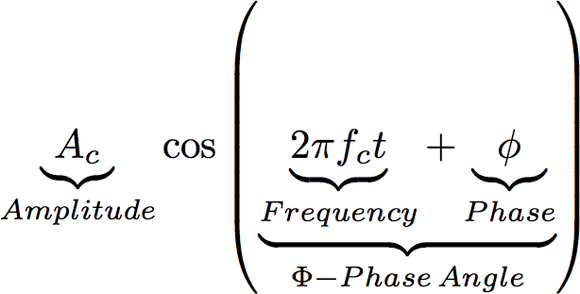
The next is the frequency of the electromagnetic wave. To explain this we need to first realize that a wave can be described with a cosine. Looking at the equation shows us almost everything we can modify or modulate with respect to the signal, with the exception of one more parameter - polarization. Those three are amplitude, frequency, and phase. Everything inside the cosine’s parameter together serves to describe the wave’s phase angle. Obviously the next possible thing to modulate is this phase angle – we could code a phase of 0 to a binary 0, and phase of π (180 degrees) to a binary 1. This is called Binary Phase Shift Keying (BPSK). You can imagine using more positions along the phase to encode more data – just go up a power of 2 and encode a phase of 0 to binary 00, phase of π/2 to 01, π to 11, and 3/2π to 10. Often this is shifted by π/4, but in either configuration with 4 points you get to Quadrature Phase Shift Keying (QPSK).
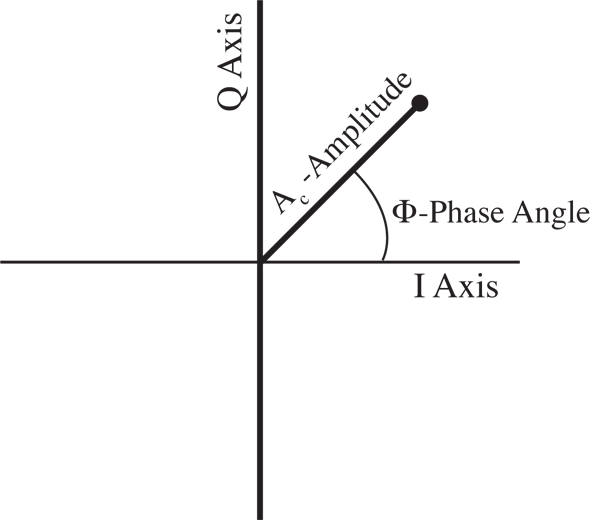
This can be visualized in polar coordinates, where the amplitude is the distance from the origin to a point, and the phase angle is simply the angle from the x-axis to the point. Now the term phase angle makes sense. A plot very similar to this is called an I/Q plot, with I standing for in-phase, and Q for quadrature (90-degrees out of phase). This is essentially a polar plot, but with the names for the two orthogonal components just labeled I and Q due to their common use in an IQ modulator.
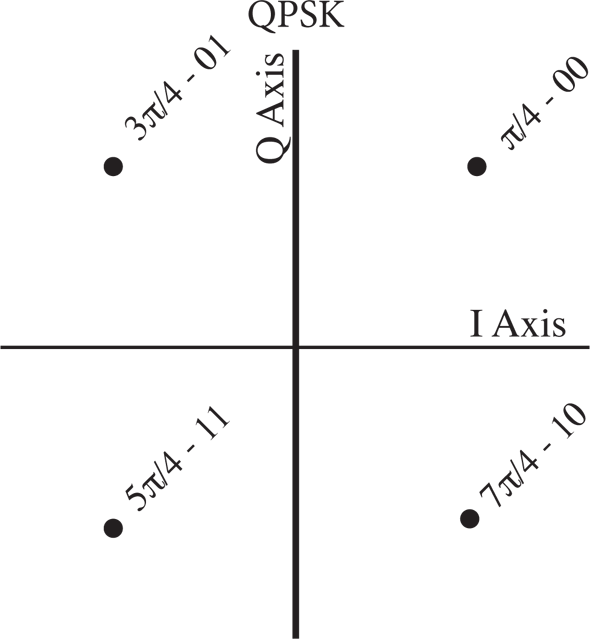
It doesn’t take much imagination to see how you can modulate amplitude alongside phase and get even more points to encode to binary data. This is called Quadrature Amplitude Modulation (QAM) and essentially is the combination of both ASK and PSK. If you divide the I/Q plot into regions, each can then correspond to some predefined coding. The encoder and decoder share this mapping, and we can transact data based on a specific value of the amplitude and phase angle.
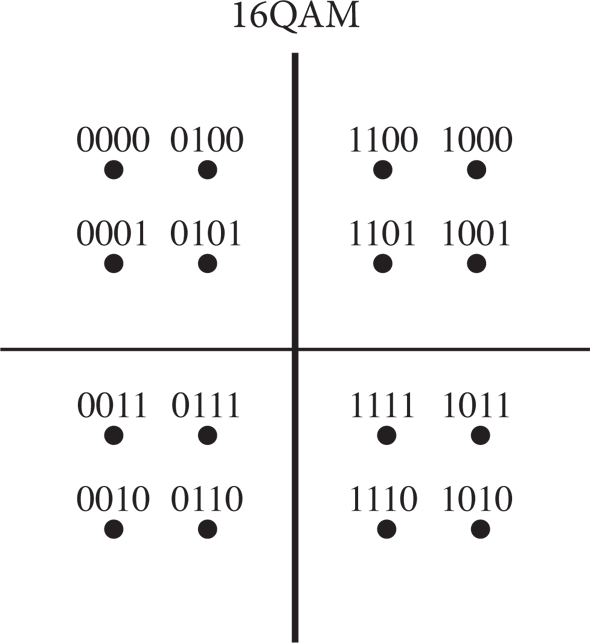
Things go by powers of two here so we can add one more digit of coding – thus 16QAM lets us code four binary digits, and 64QAM lets us code six. These different codings are simply different higher powers of QAM, and sometimes you’ll just hear them referred to as higher order modulation schemes. All we’re doing is increasing the power of two and dividing the IQ plot into more points. Plotted on the I/Q plot, these points form what’s called a constellation map.
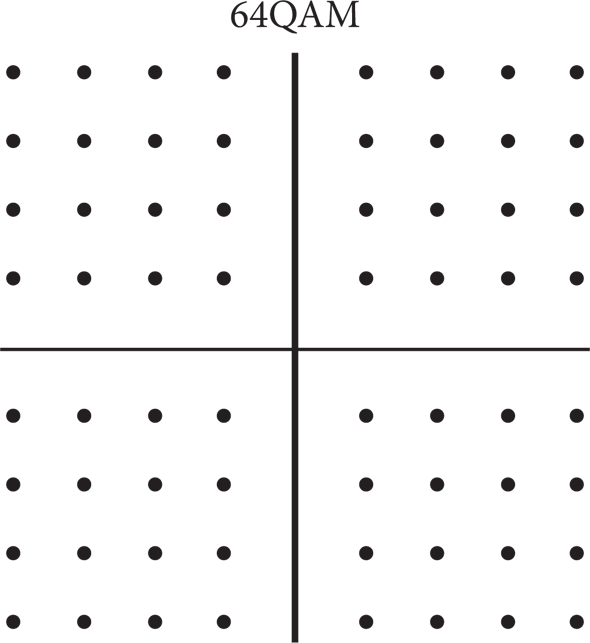
I'm not even going to bother labeling the codings on this one...
There is a tradeoff, however. Moving to more and more decision points results in a densely packed constellation, with correspondingly less space between each point. We can’t get any more area, since we’re encoding between an amplitude of 0 and 1, and phase angle of 0 and 2π. As a result, sensitivity to noise and interference goes up, as tolerances (the area between points) shrinks. On the demodulator, there’s a component called the decision circuit whose job it is to decide what coding each point should correspond to. It does its job simply by looking at where points land and how close they are to a symbol. There are ways of improving the decision circuit, but there’s no getting around the fact that each power of two makes the decision circuit’s job harder.










25 Comments
View All Comments
cptnjarhead - Tuesday, June 14, 2011 - link
I'm am excited for the pre 3.Veer is way to small for me and my pre + oc'd @ 1ghz will keep me happy till the pre 3 comes out.
WebOS is the best in mop. My wife has the same phone and this is the first smart phone that i haven't had to constantly show her how to use it :)
trust me, if you have never used WebOS, just try it and you will be amazed how great it is.
vshah - Tuesday, June 21, 2011 - link
Have you guys stopped including these as a standard part of the reviews?Brian Klug - Saturday, July 2, 2011 - link
We haven't, however as I noted there's no way to get RSSI out of the Veer.-Brian
theinvisibleduck - Monday, June 27, 2011 - link
I bought my wife one (she wanted a small phone) neither of us believed it would be big enough when I got it, but we were both pleasantly suprised! It is excellent and you do not notice that it is small (except yesterday when I lost it in my pocket and my wife and I had a heated discussion about who lost it before I started digging through my pants pocket and found it). I would HIGHLY recommend trying this awesome little device out I think you will be very pleasantly suprised like I was.CellPig - Tuesday, June 28, 2011 - link
This phone is adorable, ha. I'm very skeptical of it making it in a big phone market though. HP has such a small stance in the smart phone market to begin with and I'm not sure if this phone will get them moving in the right direction, regardless of how cool it is. I used to have a webOS device, but I switched to Android and then to Apple, each time gaining more access to things that mattered. We're actually stumped over whether or not we should stock accessories for this phone at http://CellPig.com - Anyone have thoughts/suggestions?